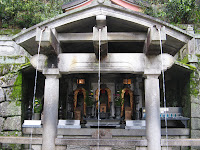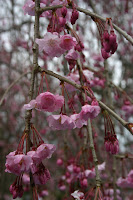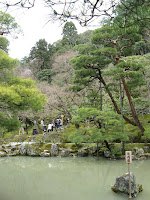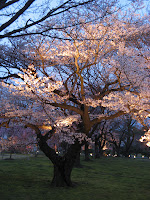We took a day trip to Kyoto, the cultural centre of Japan and one of the world's most culturally rich cities with 17 UNESCO World Heritage sites, more that 1600 Buddhist temples and over 400 Shinto shrines. Kyoto ranks on the top as one of our favourite cities in all of Asia. We had an amazing time when we visited in June 2008 and we felt we had to go back to see and experience more. We took the bullet train (Shinkansen) from Osaka to Kyoto (a quick 12 minute train ride compared to a 45 minute train ride by regular train) and arrived very early in the morning.
Kyoto has a great city bus system and like the Big Bus sightseeing tours in London, the buses make stops at all the major attractions and visitors can hop on and off at any stop. We bought a day pass and this made getting around very easy, especially since Kyoto is spread out and the attractions are scattered all over the city. It was impossible to see everything in one day, so we focused on visiting the best cherry blossom viewing spots in the city.
Kiyomizu-dera Temple
Although we visited this temple in 2008, we had read that some of the best cherry blossoms can be seen here, so we decided to go back. Unfortunately for us, a few days before we were due to arrive in Kyoto, the weather turned cold and on the day we visited, it was still cold and raining. That said, the trees were not in full bloom.
We decided to make this temple our first stop of the day, as it is one of the famous landmarks of the city and it does get crowded. Kiyomizu-dera Temple was first built in 798 and is known for its main hall with a huge veranda that is built on a hillside (offers great views of Kyoto on a clear day). Below the veranda is the waterfall Otowa-no-taki - many visitors drink the water from this waterfall as it is said to be sacred and to have therapeutic properties.
Although we visited this temple in 2008, we had read that some of the best cherry blossoms can be seen here, so we decided to go back. Unfortunately for us, a few days before we were due to arrive in Kyoto, the weather turned cold and on the day we visited, it was still cold and raining. That said, the trees were not in full bloom.
We decided to make this temple our first stop of the day, as it is one of the famous landmarks of the city and it does get crowded. Kiyomizu-dera Temple was first built in 798 and is known for its main hall with a huge veranda that is built on a hillside (offers great views of Kyoto on a clear day). Below the veranda is the waterfall Otowa-no-taki - many visitors drink the water from this waterfall as it is said to be sacred and to have therapeutic properties.



















Sannen-zaka and Ninen-zaka
After our visit to Kiyomizu-dera Temple, we made our way by foot to our next cherry blossom viewing site - Maruyama Park. On route to this park, we walked along Sannen-zaka and Ninin-zaka, two beautiful stone-paved streets that are a preservation district. Both these streets are among the most beautiful streets in Kyoto and are lined with old wooden houses, traditional shops, teahouses and restaurants.
After our visit to Kiyomizu-dera Temple, we made our way by foot to our next cherry blossom viewing site - Maruyama Park. On route to this park, we walked along Sannen-zaka and Ninin-zaka, two beautiful stone-paved streets that are a preservation district. Both these streets are among the most beautiful streets in Kyoto and are lined with old wooden houses, traditional shops, teahouses and restaurants.












Maruyama Koen
Maruyama Park is one of Kyoto's most famous and popular cherry blossom viewing spots (not surprising because we saw some of the most beautiful cherry blossoms in this park). The main feature of this park, is the large famous weeping cherry tree (shidarezakura) in the centre of the park. When we arrived at the park, it had just stopped raining, so although there were many people walking around the park, very few were sitting under the cherry tress on the blue tarps (set up specifically for picnics under the trees).
Maruyama Park is one of Kyoto's most famous and popular cherry blossom viewing spots (not surprising because we saw some of the most beautiful cherry blossoms in this park). The main feature of this park, is the large famous weeping cherry tree (shidarezakura) in the centre of the park. When we arrived at the park, it had just stopped raining, so although there were many people walking around the park, very few were sitting under the cherry tress on the blue tarps (set up specifically for picnics under the trees).



















Ginkaku-ji
Ginkaku-ji is often referred to as The Temple of the Silver Pavilion, although ironically it never received its intended silver-leaf coating. This temple was established in 1482 and was originally the mountain retreat of Shogun Ashikaga Yoshimasa, who played an important role in the emergence of the Higashiyama culture. The Higashiyama culture was greatly influenced by Zen Buddhism and is famous for amongst other things, the Japanese tea ceremony (Sado), Japanese flower arranging (Ikebana), Noh Japanese drama and ink painting. Shogun Yoshimasa became a Zen Buddhist monk in 1485 and after his death in 1490, the villa and and gardens became a Buddhist temple complex. This Zen Buddhist temple is known for its stunning garden design with an upper and lower area. The lower garden features a simplistic, yet truly stunning raised sand garden (Ginshadan), while the upper garden offers great views of the Silver Pavilion and the lower garden. It has been said that the beauty of nature at Ginakakuji can be enjoyed during each of the different seasons, giving the atmosphere of a profound spiritual world. While walking around the beautiful gardens and temple grounds, we were struck by a deep sense of peace and tranquility, a truly Zen experience !
Ginkaku-ji is often referred to as The Temple of the Silver Pavilion, although ironically it never received its intended silver-leaf coating. This temple was established in 1482 and was originally the mountain retreat of Shogun Ashikaga Yoshimasa, who played an important role in the emergence of the Higashiyama culture. The Higashiyama culture was greatly influenced by Zen Buddhism and is famous for amongst other things, the Japanese tea ceremony (Sado), Japanese flower arranging (Ikebana), Noh Japanese drama and ink painting. Shogun Yoshimasa became a Zen Buddhist monk in 1485 and after his death in 1490, the villa and and gardens became a Buddhist temple complex. This Zen Buddhist temple is known for its stunning garden design with an upper and lower area. The lower garden features a simplistic, yet truly stunning raised sand garden (Ginshadan), while the upper garden offers great views of the Silver Pavilion and the lower garden. It has been said that the beauty of nature at Ginakakuji can be enjoyed during each of the different seasons, giving the atmosphere of a profound spiritual world. While walking around the beautiful gardens and temple grounds, we were struck by a deep sense of peace and tranquility, a truly Zen experience !













Philosopher's Walk
Also known as the Path of Philosophy (Tetsugaku-no-Michi), this is one of Kyoto's best loved spots, especially for cherry blossom viewing. This 1.5 kilometre walk, follows a beautiful cherry-tree lined canal that meanders along the base of the Higashiyama (Eastern Mountains). Along the path are coffee and craft shops, restaurants, boutiques, galleries and food vendors. This path got its name from a Kyoto University Philosophy professor, Nishida Kitaro who used it for his daily constitutional. Even though it was cold, the walk was relaxing and the cherry blossoms absolutely spectacular.
Also known as the Path of Philosophy (Tetsugaku-no-Michi), this is one of Kyoto's best loved spots, especially for cherry blossom viewing. This 1.5 kilometre walk, follows a beautiful cherry-tree lined canal that meanders along the base of the Higashiyama (Eastern Mountains). Along the path are coffee and craft shops, restaurants, boutiques, galleries and food vendors. This path got its name from a Kyoto University Philosophy professor, Nishida Kitaro who used it for his daily constitutional. Even though it was cold, the walk was relaxing and the cherry blossoms absolutely spectacular.




















Heian Jingu Shrine and Gardens
This Shrine was built in 1895 to commemorate the 1100th anniversary of the founding of Kyoto. The main entrance to this shrine is marked by a massive steel tori. Toris are traditional Japanese gates that are found at Shinto shrines. These toris first made their appearance during the Heian (one of Kyoto's former names) period and were traditionally made from wood or stone. The main building of this shrine represents a replica (on a smaller scale) of the first Imperial Palace built in the Heian-Kyo in 794. Interestingly enough, the main building and layout reminded us a little of The Forbidden City in Beijing (but on a far smaller scale). The main building of this shrine is surrounded by four beautiful gardens and we saw many beautiful cherry blossom trees in these gardens.
This Shrine was built in 1895 to commemorate the 1100th anniversary of the founding of Kyoto. The main entrance to this shrine is marked by a massive steel tori. Toris are traditional Japanese gates that are found at Shinto shrines. These toris first made their appearance during the Heian (one of Kyoto's former names) period and were traditionally made from wood or stone. The main building of this shrine represents a replica (on a smaller scale) of the first Imperial Palace built in the Heian-Kyo in 794. Interestingly enough, the main building and layout reminded us a little of The Forbidden City in Beijing (but on a far smaller scale). The main building of this shrine is surrounded by four beautiful gardens and we saw many beautiful cherry blossom trees in these gardens.















Gion
Gion is known as the Geisha district in Kyoto and is also the main entertainment district. It is one of our favorite places in all of Japan. We love the architecture of the buildings and the atmosphere. There is a part of Gion that is modern (not in a concrete, neon lights way like Tokyo or Osaka), but there is also a part that has retained its traditional look with immaculate wooden buildings and quaint alleyways. It was in this area that we spotted some Geisha in 2008 and we weren't sure if we would be so lucky this time. David did manage to see two sitting in a taxi, but we didn't spot any walking around until we visited Shirakawa Minami-dori, considered by many to be the most beautiful street in all of Asia during cherry blossom season (it is a gorgeous street that is situated alongside a canal). These two Geisha we willing to pose for photographs before shuffling down the street to their appointments. It was another one of those quintessential "only in Japan" experiences.
Gion is known as the Geisha district in Kyoto and is also the main entertainment district. It is one of our favorite places in all of Japan. We love the architecture of the buildings and the atmosphere. There is a part of Gion that is modern (not in a concrete, neon lights way like Tokyo or Osaka), but there is also a part that has retained its traditional look with immaculate wooden buildings and quaint alleyways. It was in this area that we spotted some Geisha in 2008 and we weren't sure if we would be so lucky this time. David did manage to see two sitting in a taxi, but we didn't spot any walking around until we visited Shirakawa Minami-dori, considered by many to be the most beautiful street in all of Asia during cherry blossom season (it is a gorgeous street that is situated alongside a canal). These two Geisha we willing to pose for photographs before shuffling down the street to their appointments. It was another one of those quintessential "only in Japan" experiences.















Tea at Kagizen Yoshifusa
We stopped for a tea break at Kagizen Yoshifusa in Gion, one of Kyoto's oldest and best known okashi-ya (sweet shops) that sells a variety of traditional sweets. The beautiful tea room was busy, but fortunately we only had to wait about ten minutes for a table. As soon as we sat down we were served some regular Japanese tea and sweets. We were then given a Japanese menu and fortunately there was an English menu available too (the Japanese menu looked interesting so we took a picture of this). We ordered Matcha tea (so good) and wagashi (traditional Japanese confectionery). The wagashi served was mochi (pounded sweet rice), stuffed with sweet Azuki bean paste and it was delicious !
We stopped for a tea break at Kagizen Yoshifusa in Gion, one of Kyoto's oldest and best known okashi-ya (sweet shops) that sells a variety of traditional sweets. The beautiful tea room was busy, but fortunately we only had to wait about ten minutes for a table. As soon as we sat down we were served some regular Japanese tea and sweets. We were then given a Japanese menu and fortunately there was an English menu available too (the Japanese menu looked interesting so we took a picture of this). We ordered Matcha tea (so good) and wagashi (traditional Japanese confectionery). The wagashi served was mochi (pounded sweet rice), stuffed with sweet Azuki bean paste and it was delicious !









Nijo-jo
Nijo Castle was built in 1603 as the official Kyoto residence of Shogun Tokugawa Ieyasu. The castle symbolized the power, prestige and riches of the newly established Edo-based shogunate. This castle is best known for its unusually ornate interiors and "nightingale" floors. These "nightingale" floors were designed to make a bird-like sounds when walked upon, a warning of possible intruders. Unfortunately we did not get to see the interior or nightingale floors, as we arrived at dusk when the castle itself was closed. The castle grounds and gardens were however open to the public and we arrived in time to see the cherry trees being lit up. We had a great time walking around the gardens and admiring the beautiful cherry blossoms.
Nijo Castle was built in 1603 as the official Kyoto residence of Shogun Tokugawa Ieyasu. The castle symbolized the power, prestige and riches of the newly established Edo-based shogunate. This castle is best known for its unusually ornate interiors and "nightingale" floors. These "nightingale" floors were designed to make a bird-like sounds when walked upon, a warning of possible intruders. Unfortunately we did not get to see the interior or nightingale floors, as we arrived at dusk when the castle itself was closed. The castle grounds and gardens were however open to the public and we arrived in time to see the cherry trees being lit up. We had a great time walking around the gardens and admiring the beautiful cherry blossoms.

















Dango
Before we left Nijo Castle, we had to try the dango that was being prepared and sold on the castle grounds. Dango is a dumpling made from rice powder (similar to mochi, which is pounded sweet rice). There are different types of dango and although it is eaten all year round, there is a special dango that is made especially for cherry blosson season. The cherry blossom season dango is sweet and coloured (green, white and pink balls served on a skewer), and is served without a sauce. The dango we tried was covered with a thick sweetish/salty soy sauce and although the actual dumpling was good, we didn't like the sauce too much.
Before we left Nijo Castle, we had to try the dango that was being prepared and sold on the castle grounds. Dango is a dumpling made from rice powder (similar to mochi, which is pounded sweet rice). There are different types of dango and although it is eaten all year round, there is a special dango that is made especially for cherry blosson season. The cherry blossom season dango is sweet and coloured (green, white and pink balls served on a skewer), and is served without a sauce. The dango we tried was covered with a thick sweetish/salty soy sauce and although the actual dumpling was good, we didn't like the sauce too much.


Shinkansen
We took the bullet train (Shinkansen) back to Osaka that evening. The Shinkansens in Japan are really great, not only are they fast, but they run on time, and they are clean and comfortable inside. We are amazed (as we were in 2008) that people are allowed to eat and drink on the trains and yet they are spotless. People eat many meals on these bullet trains and the wonderful thing is that everyone cleans up after themselves, so there is not even a piece of paper lying on the floor. We love traveling on the Shinkansens and it is just a pity that they are not used in other coutries.
We took the bullet train (Shinkansen) back to Osaka that evening. The Shinkansens in Japan are really great, not only are they fast, but they run on time, and they are clean and comfortable inside. We are amazed (as we were in 2008) that people are allowed to eat and drink on the trains and yet they are spotless. People eat many meals on these bullet trains and the wonderful thing is that everyone cleans up after themselves, so there is not even a piece of paper lying on the floor. We love traveling on the Shinkansens and it is just a pity that they are not used in other coutries.





No comments:
Post a Comment